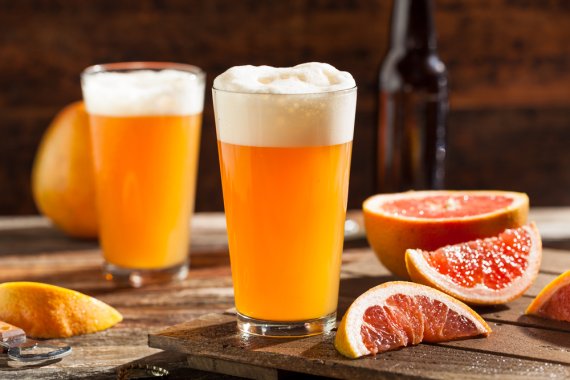© Shutterstock
‘Traditionally, beer is only brewed using brewer’s yeast’, explains Van Rijswijck, who is doing a PhD in the Food Hygiene and Microbiology group. ‘Brewer’s yeast is very efficient at converting the sugars contained in wort into alcohol, carbon dioxide and aromas. To subsequently brew beer with a lower alcohol content, one could remove the alcohol, but that is an expensive process and it might influence the taste. Brewers are therefore interested in new methods of production.’
The brewing process in brief. Wort is an intermediate product that contains a lot of sugars which are converted by yeast. © Jeffrey Mulder
[left to right: barley, water, hops, yeast, ripen, beer]
During her research, Van Rijswijck studied the metabolism of several alternative strains of yeast. She discovered that the Cyberlindnera fabianni strain is inefficient at converting the wort sugars, causing it to produce low amounts of alcohol. However, this strain produces additional aromas. Combining this strain with the traditional brewer’s yeast – creating what is called a co-culture – yielded beer with fruity aromas and low amounts of alcohol.
The ratio between the yeast strains is very important, elaborates Van Rijswijck. ‘Brewer’s yeast requires less oxygen at the start and is then able to convert all sugars into alcohol and carbon dioxide without the need for oxygen. The other strain has a higher rate of oxygen usage, causing the brewer’s yeast to lack oxygen hampering it from converting all wort sugars into alcohol. A result with little alcohol and lots of aromas is only achieved at the right ratio.’
Van Rijswijck doubts the brewers will change their processes. ‘Co-cultures are very common in the dairy industry, but brewers are very traditional and prefer to use a single kind of yeast. The application of co-cultures could be interesting for specialised breweries or even in wine production, where a complex aroma is a very important feature.’
In any case, she really enjoys the beer herself. ‘But I am not an expert. As a microbiologist, I am mainly interested in the behaviour of the yeasts.’ The self-brewed beers will be available during the reception that will follow her PhD defence on 8 September.
Additional reading:
Brewing beer using enzymes spares environment

